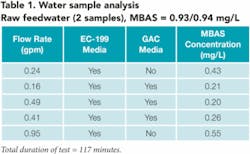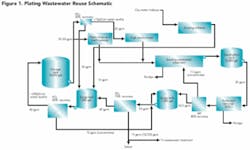By Michael Boland and Peter S. Cartwright, P.E.
A large electroplating job shop in the Minneapolis area provides contract plating services for manufacturers. As a result, the process and kind of metal plated are extremely variable with the concomitant waste stream equally variable. The company utilizes pH adjustment, coagulant addition, Lamella clarification, and fine filtration to treat rinse water streams and some of its spent plating baths.
Current city water usage is as high as 50,000 gpd, and the company is under severe pressure from local and state regulators to reduce its city water withdrawals to no more than 21,000 gpd. As a result, it chose to investigate treatment and reuse of its clarified effluent stream. The plating operation has two water treatment reverse osmosis (RO) units that purify city water for current rinsing and bath make-up activities. The city water department was contacted and the following incoming water quality parameters obtained:
- pH: 7.26-7.71
- TDS: 230–490 mg/L (350 avg.)
- Hardness: ∴290 mg/L (avg.)
Although the RO units produce water of sufficient quality, they contribute to the water quantity problem by wasting too much water (due to low system recovery).
Testing
A membrane test unit from Cartwright Consulting Co. was installed at the plating company to operate on the clarified and filtered mixed rinse wastewater. In testing wastewater streams, it’s important the unit be first run at low recovery on a “control” sample of relatively pure water (softened tap water quality or better).
Testing was initiated, and following the tap water control test, the treated wastewater was pumped into the test unit which was equipped with a spiral-wound TFC® RO membrane, 4" diameter × 40" long. Initially, pretreatment consisted of only 5μm cartridge filters. Because salts rejection dropped rapidly (an early indication of membrane surface fouling), the unit was shut down, rinsed with the tap water and restarted. Testing was performed daily for about 7 days. During testing, the unit was cleaned twice with 1% HCl and following a 15-minute acid soak and 15-minute tap water rinse, the permeate flow rate and salts rejection properties were restored.
Because the above testing indicated the need for improved prefiltration, a crossflow tubular coated stainless steel 0.1μm MF membrane element was tested as a pretreatment technology and the permeate from the unit processed through the spiral RO membrane. This pretreatment investigation also included a ceramic hollow fiber 0.05μm microfiltration (MF) element tested on the clarified effluent.
As these technologies didn’t sufficiently reduce fouling of the RO membranes, it was determined that high molecular weight soluble organic compounds, such as surfactants, were probably passing through the MF membranes into the RO membrane elements. To remove these organic contaminants, it was decided to investigate an organoclay absorbent, followed by granular activated carbon (GAC) as an adsorbent.
Two 10" filter housings were adapted for this test: one filled with 1.25 lb. EC-199 organoclay and the other with 1.0 lb standard GAC material. Testing was performed on clarified wastewater containing a high concentration of surfactant. Samples were collected and submitted to Pace Labs for MBAS (total surfactant) analysis. Results are in Table 1.




